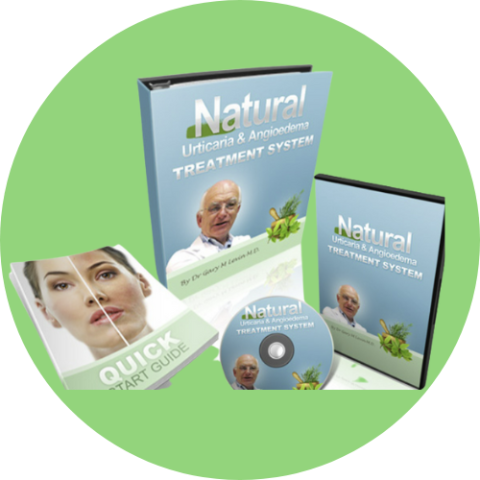4 Ways To Treat Cholinergic Urticaria: Complete Guide 2024
By Vanessa Richards
January 10, 2024 • Fact checked by Dumb Little Man
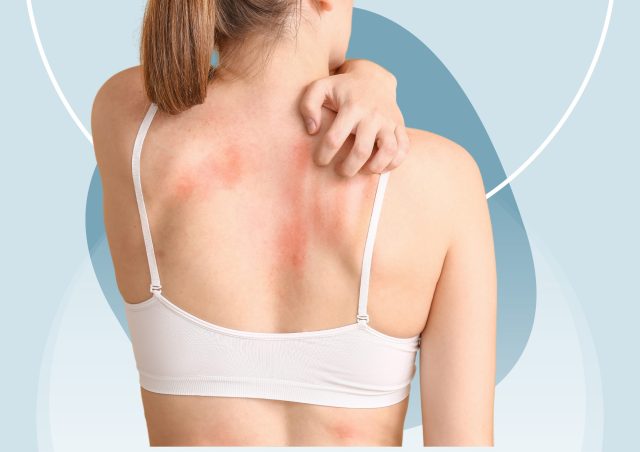
The National Weather Service has issued several warnings about record-breaking heat waves impacting most parts of the US. Over the next few decades, spiking temperatures & “oppressive heat” will be the norm as climate change worsens.
In the US, 650+ people die from preventable heat-related illnesses every year. Millions suffer from heat-triggered urticaria. Expect these figures to rise dramatically as “dangerous heat” hits much of the world in the coming decades.
Urticaria, also known as heat rash or hives, is an outbreak of red bumps on the skin. People see such pale red skin lesions appear suddenly on their skin due to many reasons.
Allergic reactions, insect stings, sunlight exposure, chemicals in certain foods, and certain medications can all cause physical urticaria. Cholinergic Urticaria (CU) is perhaps the most troublesome version of this disease. It happens when our body temperatures are raised.
Currently, cholinergic urticaria occurs in 10% of all young adults. Approximately 14% of these patients with cholinergic urticaria have to deal with the effects of this disease for 5+ years.
As global temperatures rise, so will these figures. That’s why learning the science of disabling cholinergic urticaria and curing this condition will be vital for all.
Let’s learn everything about this condition and other associated diseases to prepare for the dreaded “era of cholinergic urticaria.”
What is Cholinergic Urticaria?
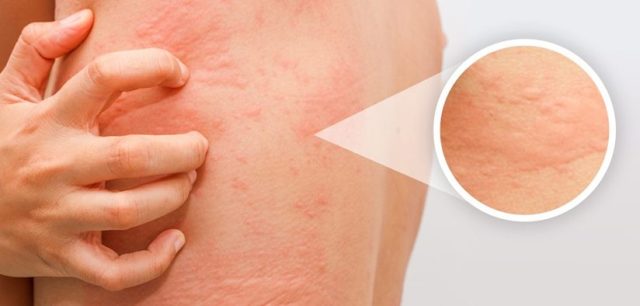
Urticaria is the medical name for hives – a specific type of rash. It’s caused when fluids fill the tissues beneath the skin. Hives appear as red, itchy skin lesions or bumps. These skin reactions look similar to the bumps/rash people get when they suffer from other skin-related conditions like:
- Atopic eczema
- Acquired Idiopathic Generalized Anhidrosis
- Atopic diathesis
- Idiopathic Pure Sudomotor Failure (IPSF)
- Atopic dermatitis
Clinical Subtypes of Physical Urticarias
But, what makes physical urticarias different is their appearance and cause. There are different types of physical urticarias caused by different factors.
Some are caused by allergic reactions, some due to infections or autoimmune diseases, & others due to sudden environmental changes.
Here are the main clinical subtypes of physical urticarias according to the World Allergy Organization Journal.
| Clinical Subtypes of Physical Urticarias | Triggers |
|---|---|
| Urticaria Factitia | Rubbing, scratching, or scrubbing excessively. |
| Cold-Induced Urticaria | When the patient’s skin is suddenly subjected to extremely cold temperatures. |
| Heat Urticaria | Patient’s skin is suddenly subjected to extremely hot temperatures. |
| Solar Urticaria | Over-exposure of the skin to sunlight and UV rays. |
| Aquagenic Urticaria | Over-exposure of the skin to water. |
| Exercise-Induced Urticaria | When the body undergoes extreme physical stress. Also known as exercise-induced anaphylaxis. |
| Recalcitrant Physical Urticaria | Severe form of physical urticaria that has many triggers like friction, pressure, solar radiation, and thermal triggers. |
Two Classifications for Chonilergic Urticaria
The most common & serious form of physical urticaria is Cholinergic Urticaria. This condition is also referred to as generalized urticaria or adrenergic urticaria. There are two types of classifications and diagnostic guidelines for cholinergic urticaria:
Chronic Spontaneous Urticaria (CSU)
No specific triggers are associated with chronic spontaneous urticaria. Signs and symptoms appear suddenly without any systemic symptoms or triggers.
Chronic Inducible Urticaria
Inducible urticaria is associated with specific triggers. A host of factors can trigger cholinergic urticaria – heat, physical stress, mental stress, and more. Either way, chronic inducible urticaria leads to a slightly delayed appearance of symptoms.
Cholinergic urticaria classifies as a form of chronic inducible urticaria. It’s characterized by the systemic manifestations of rashes on the body.
Sudden wheal formation (surrounded by bright red flares) is another clear indicator of this condition. Patients witness the formation of small, raised (approximately 1 to 4mm in height) wheals on their bodies.
These wheals can for a few minutes (15–30 minutes) or a few weeks depending on the severity of the condition.
What is the main trigger for cholinergic urticaria?
It can be a lot of things. In most cases, the main trigger is autologous sweat. Excessive sweating due to strenuous physical activities leads to the formation of itchy heat bumps on the body.
That’s why cholinergic urticaria is usually related to exercise-induced urticaria or exercise-induced anaphylaxis. Autologous sweat causes patients with these conditions to also develop heat bumps on their bodies.
Emotional stress, sweat allergy, and other allergic reactions are also other common triggers of this disease. A recent placebo-controlled study on medical school students proved that the most anxious students had higher risks of getting CU.
Although cholinergic urticaria can affect anybody at any age, its prevalence is higher in young adults. Males between the ages of 10-30 are the likeliest to suffer from this condition.
>>Related Article: 3 Ways To Treat Idiopathic Urticaria: Complete Guide 2024
Cholinergic Urticaria Symptoms
People experiencing the following cholinergic urticaria symptoms must consider seeking medical attention:
- Small, elevated bumps on the skin
- Redness and itchiness around the bumps
- Abdominal pain
- Nausea
- Diarrhea
- Hypersalivation
People who get cholinergic urticaria along with exercise-induced anaphylaxis (severe disease caused by sweat allergy) experience more intense symptoms like:
- Severe difficulty breathing
- Severe abdominal pain
- Nausea & vomiting
- Headaches
- Wheezing
Getting cholinergic urticaria along with exercise-induced anaphylaxis also means that your body will be covered with wheals. They first appear on the chest & neck regions and then spread out to other, more uncomfortable areas.
These bumps can last anywhere from a few minutes to about four hours after exercise.
What Causes Cholinergic Urticaria?
Any activity or experience that raises your body temperature increases your risk of getting cholinergic urticaria. Activities like exercising or participating in sports.
For example, can cause exercise-induced urticaria. Eating spicy foods or having a fever can cause your body to have an allergic reaction and develop cholinergic urticaria.
The same applies to emotional stress, anxiety, and other mental stresses. Activities that raise your body temperature also trigger histamine release.
The more histamine that your body releases, the more cholinergic urticaria symptoms you experience.
Triggers of Cholinergic Urticaria
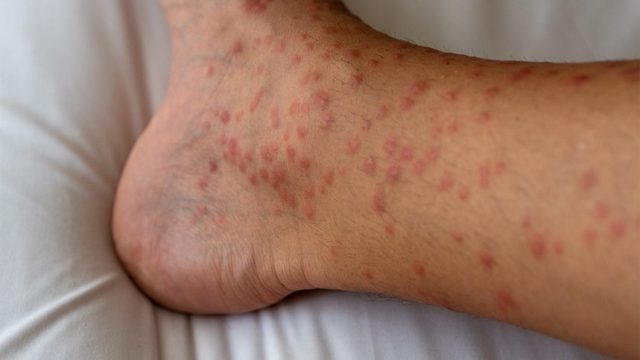
If people don’t get cholinergic urticaria successfully treated on time, itchy hives start appearing all across their bodies. This includes their tongue, throat, ears, face, & lips.
Any stimulus that over-activates a person’s sweat glands can precipitate chronic inducible urticarias like cholinergic urticaria.
They include:
| Triggers of Cholinergic Urticaria |
|---|
| Physical exercise (the most common trigger) |
| Activities that increase the core body temperature (e.g., hot water baths) |
| Eating spicy foods |
| Mental or emotional stress |
| Airborne allergens that trigger other respiratory symptoms |
| Application of direct pressure to the skin (e.g., wearing tight clothing for long periods) |
| Drug hypersensitivity |
| Environmental changes (e.g., sudden changes in temperature) |
| Food allergies (e.g., an allergic response to spicy food) |
| Insect bites |
According to the J Allergy Clin Immunol (Journal of Allergy and Clinical Immunology), certain medical conditions can also make people CU-prone. For instance, consuming certain HIV drugs makes people prone to hives.
New pathogenic concepts explaining the causes behind this condition are discussed in major journals every year.
We can learn how to prevent cholinergic urticaria by reading some studies. We can also learn some valuable symptom control techniques.
But, the full-scale treatment of cholinergic urticaria is still a hotly contested topic.
Complications of Cholinergic Urticaria
Allergy Clin Immunol Pract, Curr Allergy Asthma Rep, J Dermatol, and other journals have reported the complications of cholinergic urticaria. According to these journals, the following health issues may be connected to cholinergic urticaria:
- Anaphylactoid reactions
- Abdominal cramps
- Shortness of breath
- Angioedema
- Bronchospasm
- Hypotension
- Hepatocellular Injuries
- Asthma
- Anaphylactic reactions
Diagnostic Guidelines for Chronic Urticaria
The diagnostic guidelines for most types of physical urticaria are similar. A simple evaluation of your skin surface may be enough for a doctor to diagnose you with cholinergic urticaria.
The presence of itchy lesions that are disrupting the patients’ lives is all the clinical characteristics doctors need for diagnosis. However, some doctors may ask patients to take the following tests:
Exercise Provocation Test: If a doctor suspects you have exercise-induced anaphylaxis, he/she may ask you to exercise at their clinic. They’ll watch for symptoms to confirm their diagnosis.
Passive Warming Test: In this test, the doctor will elevate your body temperature using warm water or by increasing the room temperature. Then, they’ll assess whether the increased heat causes skin reactions.
Methacholine Skin Test: The doctor will use an intradermal injection of Methacholine for this process. After injecting methacholine into your body, they’ll see if your skin gives allergic responses.
4 Ways To Treat Cholinergic Urticaria
Is there a successful treatment for cholinergic urticaria? It depends on a case-by-case basis. Some patients have refractory cholinergic urticaria – an unfixable, unmanageable version of this condition.
For other patients, simple fixes like rapid cooling or rapid desensitization with autologous sweat work wonders.
That’s why doctors come up with custom treatment plans for different patients. In most cases, lifestyle modifications are recommended to patients.
But, making lifestyle changes can be difficult for athletes or professionals who can’t avoid strenuous physical activities in their day-to-day lives.
For them, doctors recommend different types of medicine-based therapies (e.g., anti-immunoglobulin therapy or beta-blocker therapy).
There are also several natural remedies that people with cholinergic urticaria or other forms of physical urticaria can practice at home.
1. Natural Remedies for Physical Urticaria
Here are some basic lifestyle changes for people dealing with cholinergic urticaria or other forms of physical urticaria:
- Wearing loose, airy clothing improves air circulation and reduces skin pressure.
- Avoid staying out for long periods, especially during the hottest parts of the day.
- Taking cold showers
- Taking baths with soothing agents like colloidal oatmeal
- Placing cold bandages against affected areas
- Meditation or journaling to keep your mind calm & your stress levels down
Avoiding triggers is another natural way to manage this condition. To avoid triggers for cholinergic urticaria patients can take the following steps:
- Limiting outdoor exercise, especially during the hot summer months.
- Avoiding overtime to manage work-related stress and anxiety.
- Avoiding spicy food
- Not taking hot showers and baths
- Avoiding prolonged exposure to heat
2. Dietary Changes for Preventing Physical Urticaria
Adopting low-histamine diets can help people with chronic or cholinergic urticaria. Histamine is the main chemical the body releases when it has allergic responses. Low histamine in your body means less frequent allergic responses.
Here are some dietary changes patients can take to avoid getting cholinergic urticaria symptoms:
- Salty foods
- Fish
- Shellfish
- Foods high in preservatives/additives
- Alcohol
- Dairy
- Vinegar
- Nuts
Another dietary modification that people can make is adopting an elimination diet. The logic behind an elimination diet is simple – eliminate all foods that might trigger an allergic reaction to your diet.
Find out which foods trigger allergic reactions (especially skin reactions) in your body and keep them out of your diet.
Bear in mind – there’s no one fixed diet designed for the treatment of cholinergic urticaria. Different types of diets yield different results for different people.
Anyone planning to go on an elimination diet must discuss this matter with their doctor or dietitian first.
3. Medications for the Treatment of Cholinergic Urticaria
Doctors may suggest different medications after conducting a clinical and histologic study of the patient.
Here are the most common medications prescribed to patients with cholinergic urticaria:
- Antihistamine medications suppress histamine release in the body. H1 agonists and anticholinergic drugs fall under this category of medications.
- Immunosuppressants (e.g., Cyclosporine).
- Biologic drugs like Xolair or Omalizumab have been approved for the treatment of chronic urticaria.
- Hydroxychloroquine. In a recent clinical trial, 83% of patients with hives saw positive results after using hydroxychloroquine for 3+ months.
- Autologous serum to promote autologous sweating
- Cortisone injections and steroid courses.
At present, there’s no single medication for treating cholinergic urticaria that’s classified as 100% effective.
4. Supplements and Other Solutions
When medicines and conventional treatments don’t work, people turn to alternate solutions, and rightfully so. Certain supplements can do wonders for patients with cholinergic urticaria.
For instance, according to J Dermatol & the American Osteopathic College of Dermatology, thyroid supplements can help curb this condition. Of course, most of these solutions aren’t 100% effective either.
But, there’s one product on this market that has been catching the eyes of dermatologists & patients across the country.
Life-changing Urticaria Treatment: Full Urticaria Cure By Dr Gary M.D
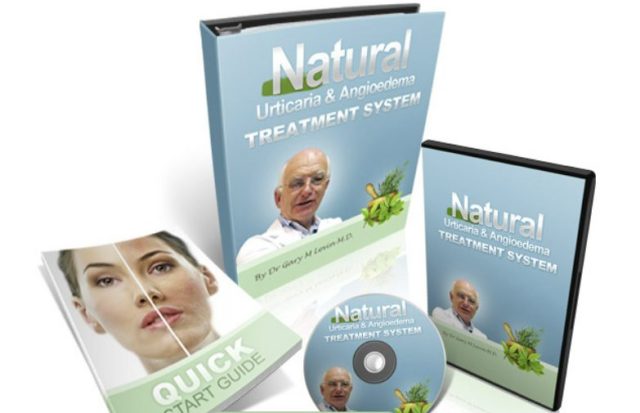
You’re probably thinking – “How can information help someone with itchy red bumps all over their body?” Well, it turns out, that obtaining science-based information on this skin disorder is the best way to prevent or treat it.
Dr. Gary M.D. is a medical professional with 20+ years of experience in the medical field. According to him, all types of skin conditions that lead to urticaria or hives are similar in one key way. The underlying causes behind these conditions are all the same.
Treating the underlying cause behind the condition and fixing the condition becomes ten times easier. That’s the motto Dr. Gary M. Levin adopts. His eBook on this topic has thousands of downloaders from across the globe.
So, it’s clear that many patients with cholinergic urticaria agree with this motto as well. Unlike most medical books, Full Urticaria Cure by Dr. Gary M. Levin hardly discusses medications.
Instead, it focuses on giving patients the correct nutrition to prevent cholinergic urticaria. It’s not as simple as adding carrots to your diet.
The doctor explained the scientific reasons behind each product and studied the neutrophil chemotactic factors of various compounds.
He presents a very molecular explanation of how different food items impact the skin. So, food items like tinned foods, processed foods, and sugary foods, are must-avoid items in Dr. Gary’s opinion.
Once you learn about the factors that increase your chances of getting this condition, you’ll naturally modify your diet.
Who is this Ebook for?
Overall, this eBook by Dr. Gary M. Levin is a must-read for anyone tackling urticaria, angioedema, and other similar conditions. You may not agree with all the revolutionary solutions for these diseases presented in this book.
But, you’ll benefit from learning the science behind urticaria and angioedema diseases. Apply whatever natural remedies, techniques, and tips for treating urticaria are mentioned in this book to your life.
Unlike taking medications, taking the steps mentioned in this book won’t hurt your health.
You’ll simply get a formal education on everything that’s been ever recorded about urticaria-related diseases. Once you’re equipped with the knowledge presented by Dr. Levin, fighting or preventing this will feel much easier.
The book costs just $47.99 & it comes with 100% moneyback guarantees.
Shop the Full Urticaria Cure Ebook at the Official Website.
>>Related Article: The Dangers of Untreated Cold Urticaria: Complete Guide 2024
When to Call the Doctor for Cholinergic Urticaria?
This skin disorder occurs periodically. You’ll see hives forming and lasting a short while on different parts of your skin. You’ll also see them go away after a while.
If this phenomenon happens multiple times, you must call a doctor. You must also call a doctor if:
- Skin lesions start appearing near your chin & mouth.
- Your tongue & lips start swelling
- Respiratory issues due to the hives.
Conclusion
We’re entering an era of record temperatures and heat waves. Under such circumstances, more and more people will get cholinergic urticaria and other forms of this horrible skin disorder.
Learning about this condition is the best way people can prevent it. That’s why resources like Full Urticaria Cure by Dr. Gary M. Levin are more important than ever.
Whether you have cholinergic urticaria or chronic spontaneous urticaria – learning about the underlying causes behind these conditions is vital. Once you do, preventing or disabling cholinergic urticaria becomes super-easy.
So, avoid the main triggers, avoid getting over-stressed or over-heated, and read books like Full Urticaria Cure. This eBook ties in all these details about food with a fundamental understanding of cholinergic urticaria.
These are the best ways to survive and thrive in the era of heat waves and skin problems.
Click here to get a Full Urticaria Cure E-book at a Discounted Price.
>> Related Article: What Causes Eczema Flare-ups? 8 Possible Triggers & Treatments
Cholinergic Urticaria FAQs
What triggers chronic spontaneous urticaria?
Temperature changes, spicy food, emotional stress, and physical exercise are the main triggers of cholinergic urticaria.
Is there a cure for cholinergic urticaria?
No, there’s no 100% effective cure for cholinergic urticaria. Different treatments work for different patients.
How long does cholinergic urticaria last?
The underlying conditions causing cholinergic urticaria may plague you for life. However, the hives and skin lesions caused by this condition usually stay on the skin for 6 to 120 minutes. However, just because the hives go away doesn’t mean that they won’t appear again later.
Is cholinergic urticaria an autoimmune disorder?
Yes. Urticaria is formed when your immune system attacks the normal tissues of your body. This results in hive and wheal formation on the skin.
Vanessa Richards
Vanessa is a mom of 3 lovely children and a software geek. Outside of her career as a health and wellness instructor. She enjoys writing and researching on topics such as finance, software, health and culinary.


